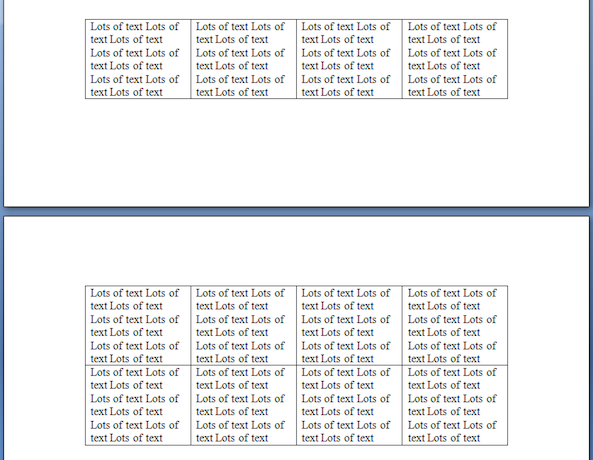Analyzing your prompt, please hold on...
An error occurred while retrieving the results. Please refresh the page and try again.
Aby uzyskać większą kontrolę nad funkcjonowaniem tabel, naucz się manipulować kolumnami i wierszami.
Kolumny, wiersze i komórki są zarządzane przez dostęp do wybranego węzła dokumentu przez jego indeks. Znalezienie indeksu dowolnego węzła polega na zebraniu wszystkich węzłów dziecięcych typu elementu z węzła macierzystego, a następnie użyciu IndexOf metoda znalezienia indeksu pożądanego węzła w kolekcji.
Czasami może być konieczne wprowadzenie zmian do konkretnej tabeli w dokumencie. Aby to zrobić, można odnieść się do tabeli po jej indeksie.
Poniższy przykład kodu pokazuje jak pobrać indeks tabeli w dokumencie:
Podobnie może być konieczne wprowadzenie zmian do określonego wiersza w wybranej tabeli. Aby to zrobić, możesz również odnieść się do wiersza po jego indeksie.
Poniższy przykład kodu pokazuje jak pobrać indeks wiersza w tabeli:
Wreszcie, może trzeba wprowadzić zmiany do konkretnej komórki, i można to zrobić również przez indeks komórki.
Poniższy przykład kodu pokazuje, jak pobrać indeks komórki w wierszu:
W Aspose.Words Document Object Model (DOM), Table węzeł składa się z Row węzły, a następnie Cell węzły. Tak więc, w Document Model obiektu Aspose.Words, jak w dokumentach Worda, nie ma pojęcia o kolumnie.
Według projektu, tabeli wiersze w Microsoft Word oraz Aspose.Words są całkowicie niezależne, a podstawowe właściwości i operacje są zawarte tylko w wierszach i komórkach tabeli. Daje to tabelom możliwość posiadania ciekawych atrybutów:

Wszelkie operacje wykonywane na kolumnach są rzeczywiście “skrótami”, które wykonują operację poprzez zbiorczą zmianę komórek wierszy w taki sposób, że wygląda na to, że są one stosowane do kolumn. Oznacza to, że można wykonywać operacje na kolumnach, po prostu powtarzając ten sam indeks komórek wiersza tabeli.
Poniższy przykład kodu upraszcza takie operacje, udowadniając klasę elewacji, która zbiera komórki, które tworzą “kolumnę” tabeli:
Poniższy przykład kodu pokazuje jak umieścić pustą kolumnę w tabeli:
Poniższy przykład kodu pokazuje jak usunąć kolumnę z tabeli w dokumencie:
Możesz powtórzyć pierwszy wiersz w tabeli jako wiersz nagłówka tylko na pierwszej stronie lub na każdej stronie, jeśli tabela jest podzielona na kilka. W Aspose.Words, możesz powtórzyć wiersz nagłówka na każdej stronie za pomocą HeadingFormat nieruchomości.
Możesz również zaznaczyć wiele wierszy nagłówka, jeśli takie wiersze znajdują się jeden za drugim na początku tabeli. Aby to zrobić, należy zastosować HeadingFormat właściwości tych wierszy.
Poniższy przykład kodu pokazuje jak zbudować tabelę zawierającą wiersze nagłówka, które powtarzają się na kolejnych stronach:
Istnieją momenty, w których zawartość tabeli nie powinna być podzielona na strony. Na przykład, jeśli tytuł jest powyżej tabeli, tytuł i tabela powinny być zawsze trzymane razem na tej samej stronie, aby zachować odpowiedni wygląd.
Istnieją dwa odrębne techniki, które są przydatne do osiągnięcia tej funkcjonalności:
Allow row break across pages, które stosuje się do wierszy tabeliKeep with next, które stosuje się do ustępów w komórkach tabeliDomyślnie powyższe właściwości są wyłączone.

Oznacza to ograniczenie zawartości wewnątrz komórek wiersza do podziału na stronę. W Microsoft Word, to można znaleźć w Właściwości tabeli jako opcja “Zezwalaj na przełamanie wiersza między stronami”. W Aspose.Words to znajduje się pod RowFormat obiekt Row jako nieruchomość RowFormat.AllowBreakAcrossPages.

Poniższy przykład kodu pokazuje jak wyłączyć łamanie wierszy pomiędzy stronami dla każdego wiersza tabeli:
Aby zatrzymać podział tabeli na strony, musimy określić, że chcemy, aby zawartość w tabeli pozostać razem.
Aby to zrobić, Aspose.Words używa metody, która pozwala użytkownikom wybrać tabelę i włączyć KeepWithNext parametr true dla każdego punktu w komórkach tabeli. Wyjątkiem jest ostatni akapit tabeli, który należy ustawić na false.

Poniższy przykład kodu pokazuje, jak ustawić tabelę, aby pozostać razem na tej samej stronie:
Analyzing your prompt, please hold on...
An error occurred while retrieving the results. Please refresh the page and try again.